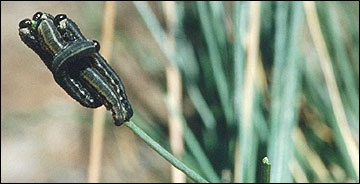European pine sawfly
Sawflies
 European pine sawfly caterpillars (Neodiprion sertifer) are present in spring and summer. They produce one generation per year.
European pine sawfly caterpillars (Neodiprion sertifer) are present in spring and summer. They produce one generation per year.
Full-grown caterpillars are nearly one inch long. They have shiny black heads and green and black thoracic legs, and the body has longitudinal (and alternating) pale green and gray-green stripes. There are eight pairs of white prolegs. The caterpillars are gregarious and primarily feed on the old needles (previous year's foliage). Preferred host plants are Scotch, red, jack and Swiss mountain pines, although white, Austrian and ponderosa pines are also attacked.
About the order
Most species in the order Hymenoptera are beneficial to agriculture as either important pollinators or as biological control agents that prey upon pestiferous insects. However, the hymenopteran group known as "sawflies" feed upon plant tissue and at times can cause serious defoliation. While adult sawflies resemble a wasp or a bee, immature sawflies are caterpillar-like, resembling the immature stage of moths or butterflies. A good diagnostic characteristic that can be used to distinguish between lepidopteran and hymenopteran "caterpillars" is the number of prolegs on the abdomen. Moth and butterfly caterpillars usually have five pairs of prolegs, four pairs on the mid-abdomen and one pair at the end of the abdomen (referred to as anal prolegs). In contrast, sawfly caterpillars typically have six or more pairs of prolegs on the abdomen. Sawfly larvae can cause significant damage to many forest trees (conifer and broadleaf) and landscape trees and shrubs.